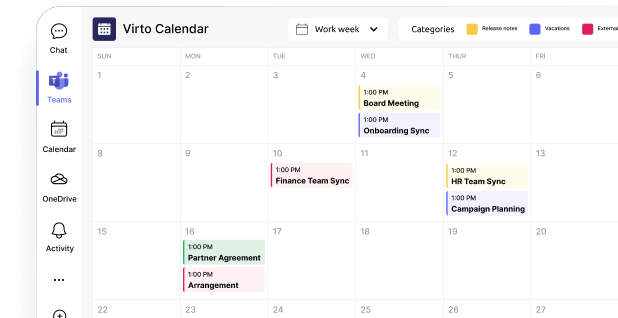SharePoint Hub Sites: for Simplified Collaboration and Easy Navigation
Discover how SharePoint Hub Sites can connect your disparate sites, streamline navigation, and foster a more cohesive digital workplace.
SharePoint sites can quickly multiply across an organization, making it challenging for teams to find and share information effectively. This is where Hub Sites come in—they’re SharePoint’s solution for bringing order to the digital chaos by connecting related sites in a way that makes sense for your business.
Hub Sites work by creating natural groupings of SharePoint sites that reflect how your organization actually operates. Rather than forcing everyone to navigate through complex hierarchies or remember exact site locations, Hub Sites provide an intuitive way to organize and access related content. For example, all marketing-related sites can be connected through a single Marketing Hub, making it simple for team members to find everything from campaign materials to brand guidelines in one cohesive space.
This modern SharePoint feature is particularly valuable for larger organizations juggling multiple departments, projects, and teams. Instead of having isolated sites scattered across your SharePoint environment, Hub Sites create a consistent experience with shared navigation, unified branding, and streamlined search capabilities. This means less time spent searching for information and more time actually getting work done.
In this article, we’ll walk through everything you need to know about Hub Sites: their standout features, practical benefits, and potential limitations. We’ll also provide clear, step-by-step guidance on setting up and customizing Hub Sites to match your organization’s specific needs.
What Is a SharePoint Hub Site?
SharePoint Hub Sites are a game-changer when it comes to organizing and managing your SharePoint environment effectively. In this section, we’ll explore what Hub Sites are, their key features, and the benefits they bring to your organization. We’ll also look at how they compare to traditional Subsites and why Hub Sites are better suited for modern businesses.
What is a Hub Site on SharePoint?
SharePoint Hub Sites offer a powerful way to organize and connect related SharePoint sites, creating a more cohesive and user-friendly intranet experience. They act as central hubs, linking multiple sites based on organizational attributes such as projects, departments, divisions, or regions. This interconnectedness simplifies navigation, enhances collaboration, and streamlines management across related sites.
Here are the key features and benefits of Hub Sites:
- Unified navigation and consistent design: Hub sites provide a shared navigation experience across all associated sites. Associating a site with a hub causes it to inherit the hub’s theme, ensuring a consistent look and feel. The hub site navigation bar appears at the top of each associated site, offering shared links and a unified browsing experience. Hub site owners can further customize this navigation using options like the mega menu layout. This unified design promotes a sense of connection and makes it easier for users to navigate between related sites.
- Streamlined management: Hub sites make administrative tasks more efficient by offering a centralized location to manage associated sites. Administrators play a key role in creating hub sites (by converting existing sites), setting limits on the number of hubs allowed within the organization, managing site association permissions, and even implementing approval workflows for site associations. This centralized control simplifies governance and oversight. Site owners, meanwhile, can independently associate their sites with existing hubs, and any new sites created directly from the hub are automatically associated, making the setup process seamless.
- Content aggregation:Hub sites use web parts to gather and display information from associated sites directly on the hub’s homepage. For instance, the News web part automatically pulls updates from linked sites, providing users with a consolidated view of recent developments. The Sites web part highlights the most active associated sites, offering quick access to key areas. Other web parts, such as Highlighted Content and Events, dynamically display relevant updates and activities from across the connected sites. This approach ensures users stay informed and engaged without needing to visit each site individually.
- Targeted search: Hub sites significantly enhance search functionality across multiple SharePoint sites. When users search from a hub site, the scope includes the hub itself and all linked sites. This targeted approach delivers more relevant results, saving users time and effort by eliminating the need to search the entire SharePoint environment. Importantly, search results respect user permissions, ensuring that individuals only see content they are authorized to access.
- Shared resources and assets: Hub sites naturally encourage the sharing of resources and assets through unified branding and shared navigation. By creating a cohesive environment, hub sites make it easier to develop and use shared tools, such as libraries, lists, templates, and other site assets. This reduces duplication of effort and ensures consistency across all associated sites.
- Home destination: Hub sites serve as a “home destination,” acting as the central access point for all information, updates, and resources related to a particular project, department, or organizational area. By curating content and offering targeted search capabilities, the hub site becomes the go-to entry point for users seeking information within its scope, streamlining access and fostering collaboration.
Practical applications of Hub Sites
Here are a few examples of how organizations can use Hub Sites:
- Departmental hubs: Consolidate related departmental sites (e.g., Marketing, Sales, HR) to create a cohesive workspace, fostering collaboration and knowledge sharing within departments.
- Project management: Organize individual project teams using linked sites, with the Hub Site serving as the central point for updates, resources, and communication, ensuring everyone stays informed and aligned.
- Sales hubs: Create a central repository for corporate sales resources, linking regional sales and communication sites for better alignment and access to the latest sales materials and best practices.
- Cross-departmental collaboration: Facilitate collaboration between departments by connecting related sites, such as Marketing and Sales, for joint projects or initiatives, breaking down silos and promoting a more integrated approach.
- Communities of practice: Connect sites related to specific areas of expertise or interest to foster knowledge sharing and collaboration among individuals with shared interests.
At their core, SharePoint Hub Sites catalyze more networked, navigable, and intuitive intranets. They streamline access to knowledge, accelerate team collaboration, and reduce management overhead.
What is Sharepoint Hub Site architecture?
Think of a hub site as a central plaza in a city. Around this plaza are various buildings, representing individual SharePoint sites. These buildings might be related, like shops in a shopping mall, or departments within a university campus. The hub site provides the common ground, the central navigation point, and the shared identity for all these related sites.
When a site joins a hub, it doesn’t physically move or become a subsite. It retains its own structure, permissions, and content. Instead, it becomes associated with the hub, like a building joining a business association. This association allows the hub site to influence the associated sites in several ways.
The hub site provides a shared navigation bar that appears across all associated sites. This allows users to easily move between related sites, regardless of their original location. The hub site also applies a common theme and logo to the associated sites, creating a unified branding experience. Furthermore, the hub site can roll out shared content and web parts to the associated sites, ensuring consistency and promoting collaboration.
However, there are some architectural constraints. You can’t have a hub site within a hub site – they can’t be nested. It’s like a city having only one central plaza, not multiple plazas within each other. If you need to connect related hubs, you can use cross-links, creating pathways between different plazas in our city analogy.
In essence, SharePoint hub site architecture is a flat, associative structure. It connects related sites without imposing a strict hierarchy, providing a flexible and scalable way to organize and navigate your SharePoint environment. It’s like creating a network of interconnected plazas, each serving a specific purpose while contributing to the overall organization and accessibility of the city.
What is the difference between Hub Site and Subsite in SharePoint?
While subsites have been the traditional way to organize information within SharePoint, Hub Sites offer a more modern and flexible approach to structuring your environment, especially for larger organizations.
Understanding subsites
Subsites are sites within a SharePoint environment. Traditionally, they were nested within a hierarchical structure, but modern SharePoint allows for more flexible arrangements. While subsites still serve a purpose, the classic hierarchical model can present challenges for larger, dynamic organizations.
Challenges of the traditional subsite model
- Complex navigation: Deeply nested subsites can create complex navigation structures, making it difficult for users to find information.
- Management overhead: Managing permissions and navigation across a large number of nested subsites can become cumbersome and time-consuming.
- Siloed information: Information can become siloed within individual subsites, hindering collaboration and knowledge sharing across teams.
Why Hub Sites offer advantages
Hub Sites provide a flatter, more flexible way to connect related sites without relying solely on deep nesting. This allows for:
- Simplified navigation: Hub Sites provide a central navigation point for all associated sites, making it easier for users to find what they need.
- Streamlined management: Administrators can easily manage associated sites from the hub, simplifying permissions, navigation, and design updates.
- Improved collaboration: By connecting related sites, Hub Sites foster collaboration and knowledge sharing across teams and departments.
- Scalability: Hub Sites offer a more scalable approach to organizing SharePoint, accommodating growth and change more effectively than rigid hierarchies.
Practical considerations
Subsites still have their place, particularly for smaller, focused teams or projects within a larger hub structure. They can provide a dedicated space for specific work while benefiting from the broader context and resources provided by the hub. Hub Sites, however, are better suited for connecting multiple related sites across departments or larger initiatives, providing a more scalable and user-friendly experience.
How to Create a SharePoint Hub Site
This section will guide you through the process of creating a Hub Site, from planning and selecting the right site to converting it into a hub, configuring its design, and associating related sites. We’ll cover everything you need to know to set up Hub Sites SharePoint effectively, ensuring your organization can take full advantage of their features.
Step-by-step guide to creating a hub site SharePoint
👉 Classic SharePoint sites cannot be directly converted into hub sites. Hub sites leverage the modern SharePoint architecture and features which are not available in classic sites. Attempting to use a classic site as a hub will result in significant limitations and prevent you from utilizing the full functionality of hub sites. Therefore, it’s essential to use a modern SharePoint site (either a communication site or a modern team site) when creating a hub site.
Step 1. Planning the Hub SharePoint strategy: The foundation for success
Before diving into the technical steps, thorough planning is essential. A well-defined strategy ensures your hub site aligns with business objectives and user needs.
- Define business outcomes: Start by identifying the specific problems you want to solve. Are you aiming to improve communication within a department, streamline access to resources, or consolidate project information? Clearly defined outcomes guide your hub site’s purpose and structure. Examples:
- Enhance HR service delivery by centralizing access to benefits, policies, and training materials.
- Improve sales team efficiency by consolidating sales resources, best practices, and customer information.
- Facilitate project collaboration by creating a central hub for project documentation, communication, and updates.
- Analyze intranet architecture: Consider your existing intranet structure. How will the new hub site integrate with other hubs or existing site collections? Visualize the information architecture and ensure the hub site complements the overall navigation and user experience.
- Plan content organization: Determine how content will be structured within the hub. Will you use a topic-based, departmental, or functional organization? Think about user journeys and how they will navigate the hub to find the information they need. Consider different “find” scenarios:
- Known item/Known location: Users know exactly what they’re looking for and where to find it. Support this with clear navigation and search.
- Known item/Unknown location: Users know what they need but are unsure where it resides. Robust search and intuitive navigation are crucial here.
- Unknown item: Users are exploring or seeking information on a general topic. Content roll-up, highlighted content, and news feeds can aid discovery.
- Establish governance policies: Define clear guidelines for content creation, approval, and publishing. Determine who will manage the hub site and associated sites. Establish a permissions model that balances security with ease of access. Consider:
- Content ownership: Who is responsible for creating and maintaining content?
- Approval workflows: Are there approval processes for publishing content?
- Permissions management: Who can associate sites with the hub? Who has access to different content areas?
- Choose the right hub site type: While both communication sites and modern team sites can be used, communication sites are generally preferred for hub sites due to their focus on broadcasting information and their visually appealing layouts.
Step 2. Creating your Hub SharePoint: A step-by-step guide
Once the planning phase is complete, you can begin creating your hub site.
- Select the site: Choose a modern communication site or team site that aligns with the hub’s purpose. The site’s existing content should be relevant to the hub’s theme.
- Convert to Hub Site (SharePoint Admin Center):
- Access the SharePoint Admin Center with administrator permissions.
- Navigate to “Active sites” and select the chosen site.
- On the command bar, click “Hub” and then “Register as hub site.”
- Enter a clear and descriptive display name for the hub.
- Crucially: Specify who can associate sites with the hub. Leaving this blank allows any user to associate, which can lead to disorganization.
- Configure navigation and design:
- Theme and branding: Apply a consistent theme that reflects your organization’s branding. This theme will cascade down to associated sites.
- Navigation: Design an intuitive navigation structure that supports user journeys and content discovery. Consider mega menus or cascading menus for complex information architectures. Ensure the navigation includes links to key resources and associated sites.
- Site designs (Optional): Leverage site designs to enforce consistent layouts and web parts across associated sites, ensuring a unified user experience.
Step 3. Associating sites with the Hub: Connecting the pieces
- Navigate to the site: Go to the SharePoint site you want to associate with the hub.
- Associate with Hub Site:
- In the site’s settings, select “Site information” and then “Associate with a hub site.” (This option will only be visible if the user has the required permissions).
- Choose the desired hub site from the dropdown menu.
- Understand content roll-up: Configure web parts like News, Events, and Highlighted Content to display content from associated sites. This provides a centralized view of information from across the hub.
- Leverage search scope: Associated sites become part of the hub’s search scope, making it easier for users to find relevant information within the context of the hub.
- Remember one hub per site: A site can only be associated with one hub at a time. For sites that logically belong to multiple hubs, use cross-navigation links to connect them.
👉So, how do I convert a SharePoint site to a Hub Site? The process is straightforward but requires administrative permissions. First, navigate to the SharePoint Admin Center and sign in with the appropriate credentials. Once there, select an existing modern site that you want to turn into a Hub Site. Next, use the “Register as Hub Site” option, where you will configure the hub’s display name and set permissions to determine who can associate other sites with the hub. After the hub is created, you can customize its navigation and theme to ensure consistency and alignment with your organization’s branding. Finally, to associate additional sites with the hub, go to each site’s settings, select the “Associate with Hub Site” option, and choose the appropriate hub to connect them. This integration links related sites, enabling centralized navigation and a unified experience.
Step 4. Ongoing Hub Site management: Maintaining and evolving
Creating a hub site is not a one-time task. Ongoing management is crucial for long-term success.
- Content management: Establish clear processes for content creation, review, and publishing within the hub and associated sites. Ensure content remains up-to-date and relevant.
- Governance enforcement: Regularly review and update governance policies to ensure they are being followed and remain effective. Address any issues with site associations or content management.
- Hub evolution: Business needs and priorities change. Be prepared to adapt the hub site’s structure, navigation, and content to reflect these changes. Regularly solicit user feedback to identify areas for improvement.
By following this guide, you can effectively plan, create, and manage SharePoint Online Hub Sites that enhance collaboration, communication, and information access within your organization. Remember that planning is paramount, and ongoing management is essential for long-term success.
👉 To learn more about planning, creating, setting up, and managing Hub Sites, refer to the following official documentation by Microsoft:
For SharePoint Hub Site examples and a guided walkthrough for creating one for your organization, please check out Create a hub site for your organization
Hub Sites Limitations and How to Work Around Them
While SharePoint hubsites offer powerful features for organizing and connecting sites, it’s essential to be aware of certain limitations and considerations to ensure optimal performance and user experience. These aren’t necessarily “hard limits” but rather factors to keep in mind during planning and implementation.
What are the limitations of Hub Sites in SharePoint?
Let’s break down these key limitations in detail below:
- Performance and Scalability:
- Associated sites: There’s no strict limit on the number of sites you can associate with a hub. However, excessive associations can potentially impact performance. Focus on creating a cohesive and manageable hub structure rather than simply associating every possible site. Regularly monitor performance and address any issues that arise.
- Hub Site quantity: Microsoft has significantly increased the allowable number of hub sites per tenant. It’s highly unlikely that most organizations will reach this limit. Focus on creating a logical and manageable number of hubs that align with your organizational structure and information architecture.
- Page and web part optimization: Excessive pages and web parts on a hub site or associated sites can impact performance. Optimize page design for efficiency, and avoid overloading pages with unnecessary web parts. Use performance monitoring tools to identify and address any bottlenecks.
- Hub Site Architecture:
- No nested Hub Sites: You cannot nest hub sites. A hub site cannot be associated with another hub site. If a site logically belongs to multiple hubs, use cross-navigation links to connect them, maintaining a clear hierarchy while providing access to related content.
- Automation Capabilities:
- Built-in automation: Hub sites offer some automation capabilities through site scripts and Power Automate. These tools can automate tasks like applying site designs and configuring navigation.
- Complex automation: For more complex automation scenarios, such as automated site association based on specific criteria, custom development or third-party tools may be required.
- Navigation design:
- Usability and performance: Excessive links in the hub navigation can negatively impact both usability and performance. Design clear and concise navigation structures that prioritize key resources and avoid overwhelming users with too many choices. The optimal number of links depends on the specific design and user needs.
- Differences from the subsite model:
- Permissions management: Hub sites offer more flexible permission management compared to the rigid inheritance model of subsites. Each associated site maintains its own permissions, allowing for granular control over access.
- Content sharing: While hub sites don’t inherently share libraries and lists in the same way subsites did, you can achieve similar functionality and consistency using modern SharePoint features like content types, site scripts, and Microsoft Syntex.
- Recycle bin: Each associated site has its own recycle bin, unlike the centralized recycle bin in the subsite model.
While SharePoint hub sites provide a robust framework for organizing and connecting sites, understanding their limitations and adopting appropriate strategies is key to maximizing their effectiveness.
Recommendations for addressing limitations
Below is a comprehensive guide to addressing the above limitations and optimizing your hub site implementation:
- Proactive planning: The foundation of success
- Information architecture analysis: Before creating any hub sites, thoroughly analyze your organization’s information architecture. Identify logical groupings of sites based on content, purpose, and user needs.
- User journey mapping: Understand how users navigate and access information. This helps design intuitive navigation structures within and between hub sites.
- Governance planning: Establish clear governance guidelines for hub site creation, association, and management. This ensures consistency and prevents uncontrolled sprawl.
- Connecting related hubs: Embracing cross-navigation
- No nested Hub Sites: Remember that hub sites cannot be nested. A hub site cannot be associated with another hub site.
- Cross-navigation strategy: Implement a clear cross-navigation strategy using links, menus, and other navigation elements to connect related hubsites. This provides seamless transitions between hubs and maintains a logical flow for users.
- Performance optimization: A continuous effort
- Regular monitoring: Continuously monitor the performance of your hub sites and associated sites. Use SharePoint’s performance monitoring tools and identify any bottlenecks or slowdowns.
- Page and web part optimization: Optimize page design for efficiency. Minimize the number of web parts on a page and use efficient web parts that load quickly. Avoid excessive use of custom code or complex web part configurations.
- Content management: Regularly review and archive outdated or unused content. This helps maintain performance and improves search relevance.
- Extending functionality: Leveraging automation and tools
- Power Automate: Utilize Power Automate to automate tasks such as site association requests, content approval workflows, and notification management.
- PowerShell: Leverage PowerShell scripting for more advanced automation scenarios, such as bulk site association, configuration management, and reporting.
- Third-party tools (consider carefully): Evaluate the need for third-party tools to address specific functionality gaps. Carefully choose reputable vendors and ensure compatibility with your SharePoint environment.
- Ongoing Maintenance and Governance: Ensuring Long-Term Success
- Regular audits: Conduct periodic audits of your hub sites and associated sites. Identify redundancies, unused content, and structural inefficiencies.
- Content cleanup: Regularly archive or delete outdated and unused content to maintain performance and improve search relevance.
- Navigation review: Periodically review your hub site navigation structures. Ensure they remain clear, concise, and aligned with user needs.
- Empowering users through training:
- User training: Provide comprehensive training for all users on how to effectively navigate and utilize hub sites.
- Administrator training: Equip hub site administrators with the knowledge and skills to manage hub sites, configure settings, and address common issues.
By addressing these limitations and implementing these optimization strategies, you can create a robust and effective hub site environment that enhances collaboration, improves information access, and empowers users to achieve their goals within SharePoint.
Best Practices and Tips for Setting Up and Using Hub Sites
This section dives into best practices for structuring and managing your SharePoint hub sites, along with exploring how additional tools can enhance their functionality and usability. We’ll cover everything from initial planning and naming conventions to leveraging automation and advanced customization options.
Best practices for using Hub Sites
Effective hub sites start with careful planning and consistent implementation. Here are some key best practices:
- Plan the structure early: Map out your information architecture, identifying logical groupings (projects, departments, regions) for linked sites. Example: A “Marketing Hub” linking “Campaigns,” “Market Research,” and “Analytics” sites.
- Unified structure: Maintain a consistent structure across all hub sites (e.g., Company Hub → Departments → Projects) for predictable navigation.
- Leverage metadata: Use metadata to tag content for improved search and filtering across related sites.
- Clear and intuitive names: Use descriptive names (e.g., “Sales Hub”) for easy identification and understanding.
- Site templates: Utilize site templates for consistent and efficient setup of associated sites.
- Regular updates: Regularly review and update your hub site structure and navigation to ensure accuracy and relevance.
Enhancing Hub Sites with additional tools
For organizations looking to extend the functionality of Hub Sites and simplify management, tools like VirtoSoftware SharePoint On-Premise Web Parts and VirtoSoftware Microsoft 365 & SharePoint Online Apps offer powerful features to enhance your intranet.
- Expanding automation capabilities
VirtoSoftware tools greatly enhance automation within Hub Sites. For instance, you can set up notifications with the Virto Alerts & Reminder App to alert users about changes in M365 calendar events or in SharePoint lists.
The Virto Workflow Automation Web Part transforms SharePoint on-premises (versions 2013 through 2019 and SharePoint SE) by allowing users to build custom workflows directly within the platform. Its extensive library of over 270 no-code activities makes creating automated processes, from simple approvals to complex multi-stage workflows, much easier. Furthermore, its broad compatibility across different SharePoint versions ensures a smooth transition during migrations. And if you need a specific activity not included in the library, you can request a custom one, typically delivered within three days.
- Improved data visualization
Virto tools excel at presenting information in a more accessible and visually appealing format. The Virto Gantt Chart App is ideal for creating interactive timelines that track project progress. You can use it to monitor deadlines, visualize task dependencies, and adjust schedules in real time.
Similarly, the Virto Kanban Board App transforms task management by presenting tasks as movable cards divided into columns based on their status. This visual representation makes it easy for teams to track progress, identify bottlenecks, and prioritize tasks effectively.
- Integration with calendars and tasks
Managing events and tasks across Hub Sites becomes seamless with tools like the Virto Calendar App and Virto Kanban Board App.
The Virto Calendar App consolidates events from multiple sources, such as SharePoint lists, Exchange, Google, and even external calendars through iCal links, into one unified view. This allows users to overlay and color-code calendars for better organization and planning. Features like mini-calendar views, customizable timescales (day, week, month, year), and event synchronization make it a versatile tool for any team.
Meanwhile, the Virto Kanban Board App offers an intuitive way to manage tasks visually. Team members can update statuses, prioritize work, and collaborate in real-time using customizable kanban boards. This integration makes it easy to keep track of what’s happening across Hub Sites, ensuring deadlines and tasks are managed efficiently.
- Security support
Ensuring robust security is critical when managing Hub Sites, and VirtoSoftware tools provide advanced capabilities for centralized access and permission management. For instance, the Virto Password Reset & Recovery app empowers users with self-service password management, enhancing both convenience and security. Users can quickly recover forgotten passwords through a user-friendly interface, reducing downtime and reliance on IT support. This self-service capability frees up IT administrators to focus on other tasks. The app also helps organizations maintain security compliance by allowing administrators to enforce password complexity rules and manage password resets for entire groups.
Managing user profiles becomes much simpler with the Virto Active Directory User Profile Sync app. It synchronizes Active Directory profiles with SharePoint, allowing users and administrators to update profiles directly within SharePoint. This simplifies data maintenance and improves accuracy. The app also offers flexible customization, allowing administrators to define which users or groups can edit specific profile fields, ensuring data security and control. The automated synchronization between SharePoint and Active Directory keeps user information consistent across both systems.
As you can see, incorporating tools like VirtoSoftware SharePoint Web Parts and VirtoSoftware Microsoft 365 Apps allows you to overcome common limitations, automate processes, and enhance the overall functionality of your Hub Sites. These tools provide customizable dashboards, advanced data visualizations, streamlined navigation, and seamless integration with calendars and task management systems, ensuring your organization’s Hub Sites remain a powerful tool for collaboration and productivity.
Conclusion
SharePoint Hub Sites are a powerful tool for organizations looking to streamline their intranet structure and improve overall efficiency. By enhancing navigation, ensuring interface consistency, unifying design across associated sites, and offering centralized management and search capabilities, Hub Sites provide a solid foundation for creating a cohesive and user-friendly digital workspace. Properly implemented, they can transform how teams collaborate and access information, reducing friction and improving productivity.
Using Hub Sites is an excellent way to optimize your SharePoint structure, making it easier to organize workflows and align them with your organization’s goals. A well-thought-out setup ensures that users can quickly locate resources, engage with relevant content, and work effectively within a structured environment.
For those looking to extend the functionality of Hub Sites, tools like Virto Software provide additional customization options, enhanced automation capabilities, and improved data visualization. These tools complement SharePoint’s native features, enabling organizations to tailor Hub Sites to meet their unique needs and further boost operational efficiency.
We encourage you to schedule a quick demo of VirtoSoftware solutions or browse the site for more information.
We also encourage you to explore additional resources to deepen your understanding of SharePoint Hub Sites and discover best practices for their implementation:
Official Microsoft Resources:
- What is a SharePoint hub site?
- Planning your SharePoint hub sites
- Create a hub site in SharePoint
- Set up your SharePoint hub site
- SharePoint hub sites overview









